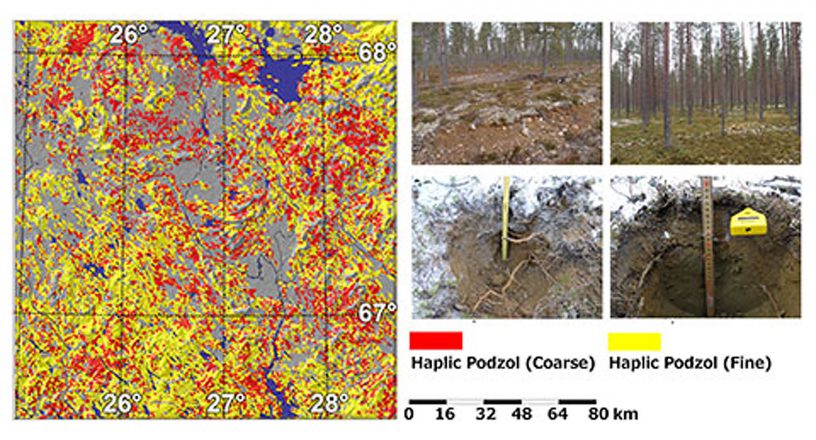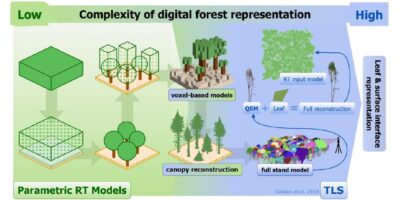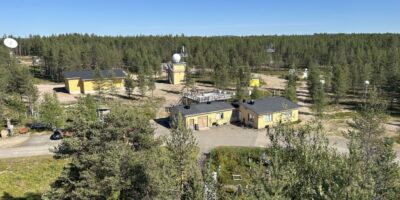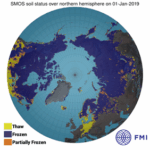In-depth, spatially distributed evaluation of the ESA CCI Soil Moisture product over a typical Northern boreal forest/taiga environment was conducted in the surroundings of the FMI Sodankylä Arctic Space Centre.
For the first time, due to the exceptionally extensive and reliable ground observation dataset, soil moisture product evaluation has been possible. In contrast to other previous studies, and the challenges commonly found in retrieving soil moisture in boreal and arctic environments, the ESA CCI Soil Moisture products do exhibit reasonably good performance. Further improvements, even with current Earth Observation methods, may be possible. With the onset of climate change, and the continued increasing economic and social importance of the northern boreal zone, more emphasis on providing tangible error characterizations and applicability assessments for satellite-based soil moisture retrievals is becoming more important.
Typically, studies that include evaluation sites in boreal environments do not go be beyond a relatively simple, single pixel/point scale evaluation, or beyond an evaluation against readily available global scale land surface model data, which in themselves may contain large uncertainties and assumptions. In order to address this issue, an in-depth evaluation of the European Space Agency’s (ESA) Climate Change Initiative (CCI) Soil Moisture (SM) product and its components; ACTIVE and PASSIVE soil moisture retrievals was conducted by a research team from FMI’s Space and Earth Observation Centre (FMI-SPACE). The performance of a spatially distributed soil moisture model (SAC-SMA) was first validated by using in situ observations collected from the FMI Arctic Space Centre, near the town of Sodankylä, in Northern Finland. SAC-SMA model top soil layer moisture estimates were then used for spatially distributed ESA CCI SM product evaluation. The study domain covered an area of 155 km by 140 km. Evaluation was performed for thawed/snow-free periods between 2003 and 2015.
The overall results of the study show far better ESA CCI SM product correlation to the used reference soil moisture dataset than previous studies have shown for boreal environment sites. This is likely due to two key factors; 1) previous studies have used either individual in situ observation sites with a limited consideration of the local representativeness of these sites, and little to no attention has been placed on the spatial scale issues involved in comparing point observations to a product representing a much larger footprint; and 2) other evaluation studies utilize global scale Land Surface Model top layer soil moisture estimates as the reference dataset, which in themselves may contain large uncertainties and are not necessarily capable of accurately reproducing soil moisture conditions that reflect local small-scale variations.
One of the most intriguing finding was the high negative correlation between pixel-pair soil moisture time series and distance (i.e. high inter-pixel cross-correlation dependency on distance) of the ACTIVE soil moisture product. Further, the ACTIVE product exhibits high average study domain wide inter-pixel soil moisture time series cross-correlation, which in itself is suspicious when considering that neighboring pixels even with very different soil/vegetation type distributions correlate to a high degree with each other. In contrast, the PASSIVE and SAC-SMA models exhibited fairly low negative inter-pixel soil moisture cross-correlation dependency on distance. The ESA CCI PASSIVE soil moisture product correlates well with pixels containing large organic soil fractions. Organic soils (bogs) tend to react slowly to precipitation and represent soil moisture change as a smooth trend. Since organic soils represent a trend, correlation to this is as a positive thing. The PASSIVE product exhibits poor correlation with pixels containing large fractions of shallow soils, i.e., rapidly responding type soils. This suggests that the ESA CCI PASIIVE product is able to, in most cases, capture the temporal trend in soil moisture variation. However, although the trend is seemingly captured, rapid response to precipitation events is less accurate. With the ACTIVE product, although there is a very significant dependency on shallow soils fraction size to SAC-SMA model correlation, there is no other statistically significant soil/vegetation type predictor that explains ESA CCI ACTIVE Soil Moisture product performance. This and the high degree of inter-pixel, distance-based spatial association are strong indicators that the ACTIVE product’s soil moisture fluctuations are largely unresponsive to changes in soil types between the pixels. If other studies are able to corroborate our findings, information on sub-pixel soil types could be used to improve the ESA CCI SM COMBINED product’s performance over boreal environments.

Distribution of organic (Histosols) and semi-organic (Umbric Gleysols) soils within the Sodankylä region (left panel) and typical top soil profiles and vegetation (right panels).
More information:
Researcher Jaakko Ikonen, tel. +358 40 8244049, jaakko.ikonen@fmi.fi
Ikonen, J., Smolander, T., Rautiainen, K., Cohen, J., Lemmetyinen, J., Salminen M., Pulliainen J. (2018). Spatially Distributed Evaluation of ESA CCI Soil Moisture Products in a Northern Boreal Forest Environment, Geosciences 2018, 8(2), 51; doi:10.3390/geosciences8020051








Leave a Reply
You must be logged in to post a comment.